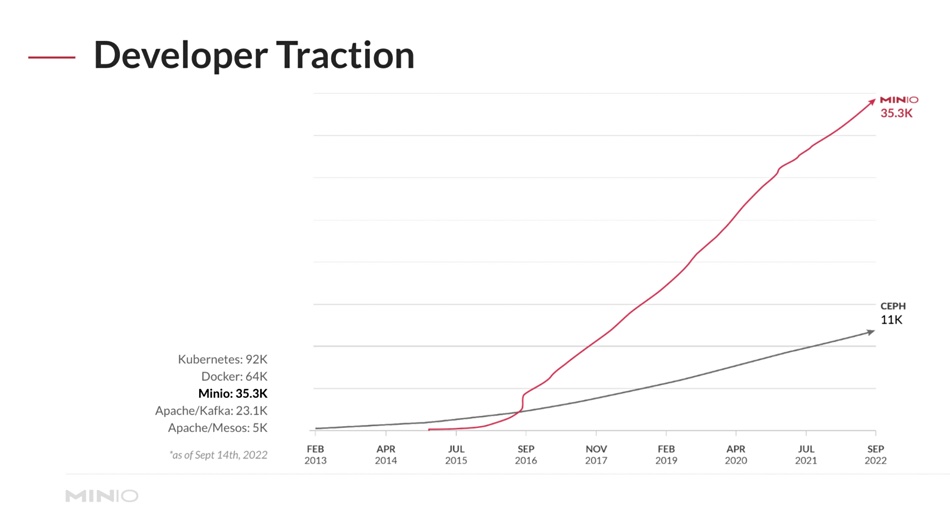MinIO has celebrated more than 1 billion downloads of its software, making it the world’s most widely used object storage.
MinIO was started in 2014 to develop cloud-native and open source object storage software, with a goal to be AWS S3 for the rest of the world. It has become the most popular object storage software ever, following the trail blazed by Linux and the Apache HTTP server.
AB Perisamy, co-founder and CEO, said: “Developers are the engine of value creation in the enterprise. By building a product targeted at them, we have changed the storage landscape – making the appliance model obsolete, challenging legacy SAN/NAS implementations and altering the perspective of what object storage was capable of. Developers and architects are partners in our journey and we are humbled by their endorsement.”
The company raised $103 million at the start of the year, with a $1 billion valuation, and says it has more than doubled its revenue since then.
MinIO says 75 percent of the Fortune 100 run MinIO so it is far from being just a small and medium enterprise play. There have been as many as 1.3 million Docker downloads a day this year, with an average of just under 1 million, 11 every second. COO and co-founder Garima Kapoor said: “Those pulls don’t even account for other hubs (Quay.io for example) or private repositories, the real number is likely far higher but we count what we can measure directly.”
The total Docker pull number was 756 million in January this year.
Other popularity numbers abound: the MinIO Slack community channel is approaching 20,000 members up from 16,000 in January. MinIO recently achieved its 35,000th GitHub star, putting it in the top 250 public repositories on the platform out of more than 28 million. MinIO says this milestone is more than three times the next open source object store, Ceph, despite being 10 years younger.

Kapoor declared: “No storage company has ever captured the developer mindset like MinIO has. No file store, no block store, no object store. Storage was dull, uninteresting and the purview of IT administrators. MinIO has made it a first class citizen as a data store – on par with databases (RDBMS, document, graph, time series, columnar, search engine), key value stores and analytics engines.”
Andy Green, VP Global Infrastructure & IT Operations at PRGX, observed: “MinIO’s Kubernetes-native object store is lightweight and can be packed densely on a server, making it ideal for containerization. This also enables MinIO to run anywhere and on any cloud, from the edge to the data center.”
It is available and deployed on Google Kubernetes Engine, Amazon’s Elastic Kubernetes Service, Azure Kubernetes Service, private cloud deployments on Red Hat OpenShift, VMware Tanzu, HPE Ezmeral, and SUSE Rancher in addition to millions of colo and edge deployments.
Kapoor said it’s a cloud world: “Think about it for a second. If you are a developer and you have the choice between Hitachi Vantara or AWS, which would you choose? If the decision was between Dell ECS and Azure, what would you decide? The decision would be instantaneous. You would go with the one that fits the cloud operating model.”
Well, yes, but not necessarily if you are a developer stuck in a vendor’s object storage shop.
Kapoor asks: “If the decision was between MinIO and GCP/AWS/Azure – there is a decision to be made. Why? Because they are functionally the same. Cloud-native, performant, Kubernetes-ready object stores.”
MInIO runs on any of them: “That is why architects choose MinIO, because they know that even if today they are not multi-cloud, that tomorrow they will be and that MinIO is the only way not to rewrite the application layer.”








